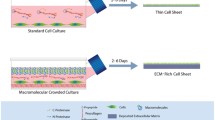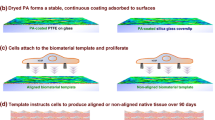Abstract
Tissue engineering by self-assembly allows for the formation of living tissue substitutes, using the cells’ innate capability to produce and deposit tissue-specific extracellular matrix. However, in order to develop extracellular matrix-rich implantable devices, prolonged culture time is required in traditionally utilized dilute ex vivo microenvironments. Macromolecular crowding, by imitating the in vivo tissue density, dramatically accelerates biological processes, resulting in enhanced and accelerated extracellular matrix deposition. Herein, we describe the ex vivo formation of corneal stromal-like assemblies using human corneal fibroblasts and macromolecular crowding.
Access this chapter
Tax calculation will be finalised at checkout
Purchases are for personal use only
Similar content being viewed by others
References
Fini ME, Stramer BM (2005) How the cornea heals: cornea-specific repair mechanisms affecting surgical outcomes. Cornea 24(8 Suppl):S2–S11
Radner W, Zehetmayer M, Aufreiter R, Mallinger R (1998) Interlacing and cross-angle distribution of collagen lamellae in the human cornea. Cornea 17(5):537–543
Fini ME (1999) Keratocyte and fibroblast phenotypes in the repairing cornea. Prog Retin Eye Res 18(4):529–551
Hay ED (1980) Development of the vertebrate cornea. Int Rev Cytol 63:263–322
Kumar P, Pandit A, Zeugolis D (2016) Progress in corneal stromal repair: from tissue grafts and biomaterials to modular supramolecular tissue-like assemblies. Adv Mater 28(27):5381–5399. https://doi.org/10.1002/adma.201503986
Guillame-Gentil O, Semenov O, Roca AS, Groth T, Zahn R, Voros J, Zenobi-Wong M (2010) Engineering the extracellular environment: strategies for building 2d and 3d cellular structures. Adv Mater 22(48):5443–5462. https://doi.org/10.1002/adma.201001747
Peck M, Dusserre N, McAllister TN, L’Heureux N (2011) Tissue engineering by self-assembly. Mater Today 14(5):218–224. https://doi.org/10.1016/S1369-7021(11)70117-1
Canty EG, Kadler KE (2005) Procollagen trafficking, processing and fibrillogenesis. J Cell Sci 118(Pt 7):1341–1353. https://doi.org/10.1242/jcs.01731
Sorushanova A, Delgado L, Wu Z, Shologu N, Kshirsagar A, Raghunath R, Mullen A, Bayon Y, Pandit A, Raghunath M, Zeugolis D (2019) The collagen suprafamily: from biosynthesis to advanced biomaterial development. Adv Mater 31(1):e1801651. https://doi.org/10.1002/adma.201801651
Kumar P, Satyam A, Fan X, Collin E, Rochev Y, Rodriguez BJ, Gorelov A, Dillon S, Joshi L, Raghunath M, Pandit A, Zeugolis DI (2015) Macromolecularly crowded in vitro microenvironments accelerate the production of extracellular matrix-rich supramolecular assemblies. Sci Rep 5:8729. https://doi.org/10.1038/srep08729
Kumar P, Satyam A, Fan X, Rochev Y, Rodriguez BJ, Gorelov A, Joshi L, Raghunath M, Pandit A, Zeugolis DI (2015) Accelerated development of supramolecular corneal stromal-like assemblies from corneal fibroblasts in the presence of macromolecular crowders. Tissue Eng Part C Methods 21(7):660–670. https://doi.org/10.1089/ten.TEC.2014.0387
Graceffa V, Zeugolis D (2019) Carrageenan enhances chondrogenesis and osteogenesis in human bone marrow stem cell culture. Eur Cell Mater 37:310–332. https://doi.org/10.22203/eCM.v037a19
Graceffa V, Zeugolis D (2019) Macromolecular crowding as a means to assess the effectiveness of chondrogenic media. J Tissue Eng Regen Med 13(2):217–231. https://doi.org/10.1002/term.2783
Cigognini D, Gaspar D, Kumar P, Satyam A, Alagesan S, Sanz-Nogues C, Griffin M, O'Brien T, Pandit A, Zeugolis DI (2016) Macromolecular crowding meets oxygen tension in human mesenchymal stem cell culture - a step closer to physiologically relevant in vitro organogenesis. Sci Rep 6:30746. https://doi.org/10.1038/srep30746
Satyam A, Kumar P, Fan X, Gorelov A, Rochev Y, Joshi L, Peinado H, Lyden D, Thomas B, Rodriguez B, Raghunath M, Pandit A, Zeugolis D (2014) Macromolecular crowding meets tissue engineering by self-assembly: a paradigm shift in regenerative medicine. Adv Mater 26(19):3024–3034. https://doi.org/10.1002/adma.201304428
Gaspar D, Fuller K, Zeugolis D (2019) Polydispersity and negative charge are key modulators of extracellular matrix deposition under macromolecular crowding conditions. Acta Biomater 88:197–210. https://doi.org/10.1016/j.actbio.2019.02.050
Acknowledgements
This work has been supported from: Science Foundation Ireland, Career Development Award Programme (grant agreement number: 15/CDA/3629) and Science Foundation Ireland and the European Regional Development Fund (grant agreement number: 13/RC/2073). Mehmet Gürdal was supported by The Scientific and Technological Research Council of Turkey (TÜBİTAK), Science Fellowships and Grant Programmes Department (BİDEB), Programme of 2214-A Ph.D. Research Scholarship for Abroad. The authors have no competing interests.
Author information
Authors and Affiliations
Corresponding author
Editor information
Editors and Affiliations
Rights and permissions
Copyright information
© 2020 Springer Science+Business Media, LLC, part of Springer Nature
About this protocol
Cite this protocol
Gürdal, M., Ercan, G., Zeugolis, D.I. (2020). Formation of Corneal Stromal-Like Assemblies Using Human Corneal Fibroblasts and Macromolecular Crowding. In: Ahearne, M. (eds) Corneal Regeneration. Methods in Molecular Biology, vol 2145. Humana, New York, NY. https://doi.org/10.1007/978-1-0716-0599-8_9
Download citation
DOI: https://doi.org/10.1007/978-1-0716-0599-8_9
Published:
Publisher Name: Humana, New York, NY
Print ISBN: 978-1-0716-0598-1
Online ISBN: 978-1-0716-0599-8
eBook Packages: Springer Protocols




